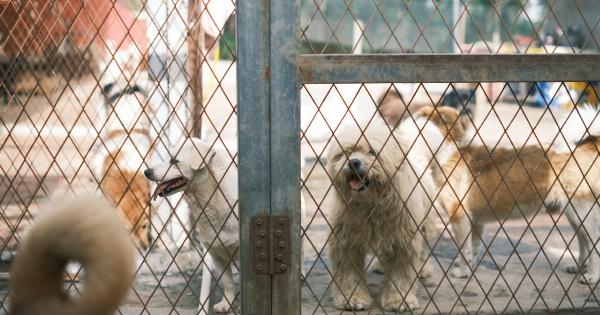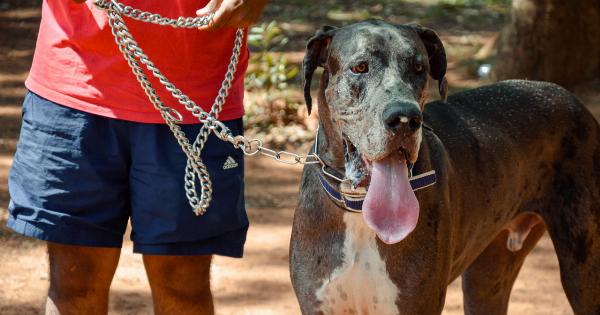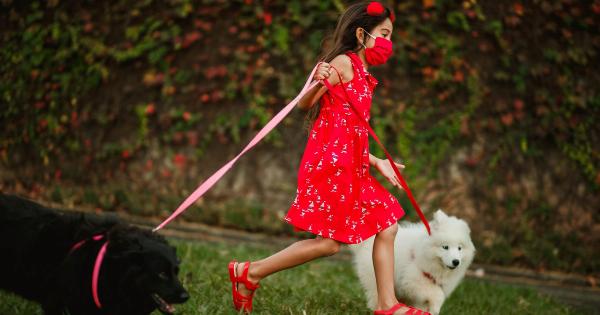As a dog owner, it is essential to understand your furry friend’s body language to ensure a healthy and safe interaction.
While most people are aware that a wagging tail signifies happiness and friendliness in dogs, it’s crucial to recognize that the wagging tail can have different meanings depending on the situation. Dogs may wag their tails aggressively or fearfully, and knowing the signs can prevent potentially dangerous situations.
In this article, we will delve into the various tail wagging behaviors and other body language cues to help you better understand your canine companion.
Aggressive Tail Wagging – False Friendliness
Contrary to popular belief, a wagging tail does not always indicate a happy dog. A dog wagging its tail aggressively can be a warning sign of potential aggression. The tail may be wagging stiffly from side to side or held high and vigorously.
This type of tail wagging is often accompanied by other aggressive body language, such as a stiff posture, raised hackles, and an intense stare.
It’s important to note that an aggressive tail wag does not necessarily mean the dog will attack, but it does indicate that the dog is not comfortable or friendly in that moment.
It can be a signal of potential danger and should not be ignored or misinterpreted. Approaching a dog with an aggressive tail wag without caution can result in bites or other aggressive behaviors.
Understanding Fearful Tail Wagging
On the other end of the spectrum, a fearful tail wag is a symptom of anxiety, nervousness, or fear. It is crucial to identify these signs to prevent escalating fear or potential harm.
A fearful tail wag is often low, tucked between the hind legs or under the belly, and may be accompanied by other fearful body language cues such as crouching, hiding, or avoiding eye contact.
Dogs with a fearful tail wag may be experiencing stress or anxiety due to unfamiliar surroundings, loud noises, or traumatic experiences.
It is essential to create a safe and comfortable environment for these dogs and avoid triggering situations that exacerbate their fear. Pushing a fearful dog into interactions or forcing them out of their comfort zone can lead to aggression or further fear-related issues.
Other Body Language Cues to Look Out For
While tail wagging is a prominent body language cue, it is crucial to observe other signals dogs exhibit to gather a comprehensive understanding of their emotional state. Here are some other body language cues commonly displayed by dogs:.
1. Ears
The positioning and movement of a dog’s ears can indicate their mood. Ears held upright often signify alertness and attention. When the ears are flattened or pinned back against the head, it usually indicates fear, submission, or anxiety.
Be cautious when approaching a dog with flattened ears as they may be on guard or uncomfortable.
2. Eyes
A dog’s eyes can provide valuable insights into their emotions. Dilated pupils indicate excitement or fear, while narrowed pupils can suggest aggression or stress.
Locked eye contact can be perceived as a challenge or threat, especially if accompanied by other aggressive body language cues.
3. Body Posture
The position of a dog’s body can convey a lot about how they are feeling. Confident and relaxed dogs stand tall with weight evenly distributed on all four legs.
Conversely, fearful or anxious dogs may crouch, lower their body, or even roll onto their backs as a submissive gesture.
4. Facial Expressions
Similar to humans, dogs can display various facial expressions that convey their emotions. A relaxed, open mouth with a lolling tongue usually signifies a friendly and content dog.
Conversely, a closed mouth or lips pulled back can indicate tension, fear, or aggression.
5. Tail Position
While we have discussed aggressive and fearful tail wags, it is important to pay attention to a dog’s tail position in general. A relaxed dog typically holds their tail in a neutral position, neither too high nor too low.
A raised tail can suggest confidence, alertness, or aggression, while a tucked tail indicates fear or submission.
6. Vocalizations
Along with body language cues, dogs communicate through vocalizations. Growling, barking, whimpering, or howling can indicate warning signs or specific emotional states.
It is important to interpret these vocalizations alongside other body language signals to determine the context and meaning behind them.
Creating a Safe Environment for Dogs
Understanding dog body language allows us to create a safe and comfortable environment for our canine companions. By recognizing their emotions and responses, we can prevent potential conflicts and promote positive interactions.
Here are some tips to create a safe environment:.
1. Educate Yourself
Learn about different dog breeds and their typical body language. Understanding breed-specific behaviors can help you interpret your dog’s signals better.
2. Observe and Learn
Take the time to observe your dog’s body language in various situations and moods. This will help you recognize patterns and better understand their communication style.
3. Patient Training
When training your dog, use positive reinforcement techniques and be patient. Avoid aversive training methods that can cause fear or aggression.
4. Provide a Safe Haven
Ensure that your dog has a safe space or a designated retreat area where they can relax and feel secure when needed. This can be a crate, a specific room, or a comfortable bed.
5. Socialize Properly
Expose your dog to various social situations and environments from an early age. Proper socialization can help them feel more comfortable and confident around people, other animals, and new experiences.
6. Seek Professional Help
If you are unsure about interpreting your dog’s body language or your dog exhibits concerning behaviors, consult a professional dog trainer or animal behaviorist for guidance.
Conclusion
Understanding dog body language is crucial for responsible dog ownership. Dogs communicate primarily through their body language, and recognizing the signs can prevent potentially dangerous situations.
Tail wagging is just one aspect of a dog’s communication, and it can indicate aggression or fear depending on the context and accompanying body language cues. By observing and interpreting a dog’s overall body language, including ears, eyes, posture, facial expressions, and vocalizations, we can foster a safe and happy environment for our furry friends.






























